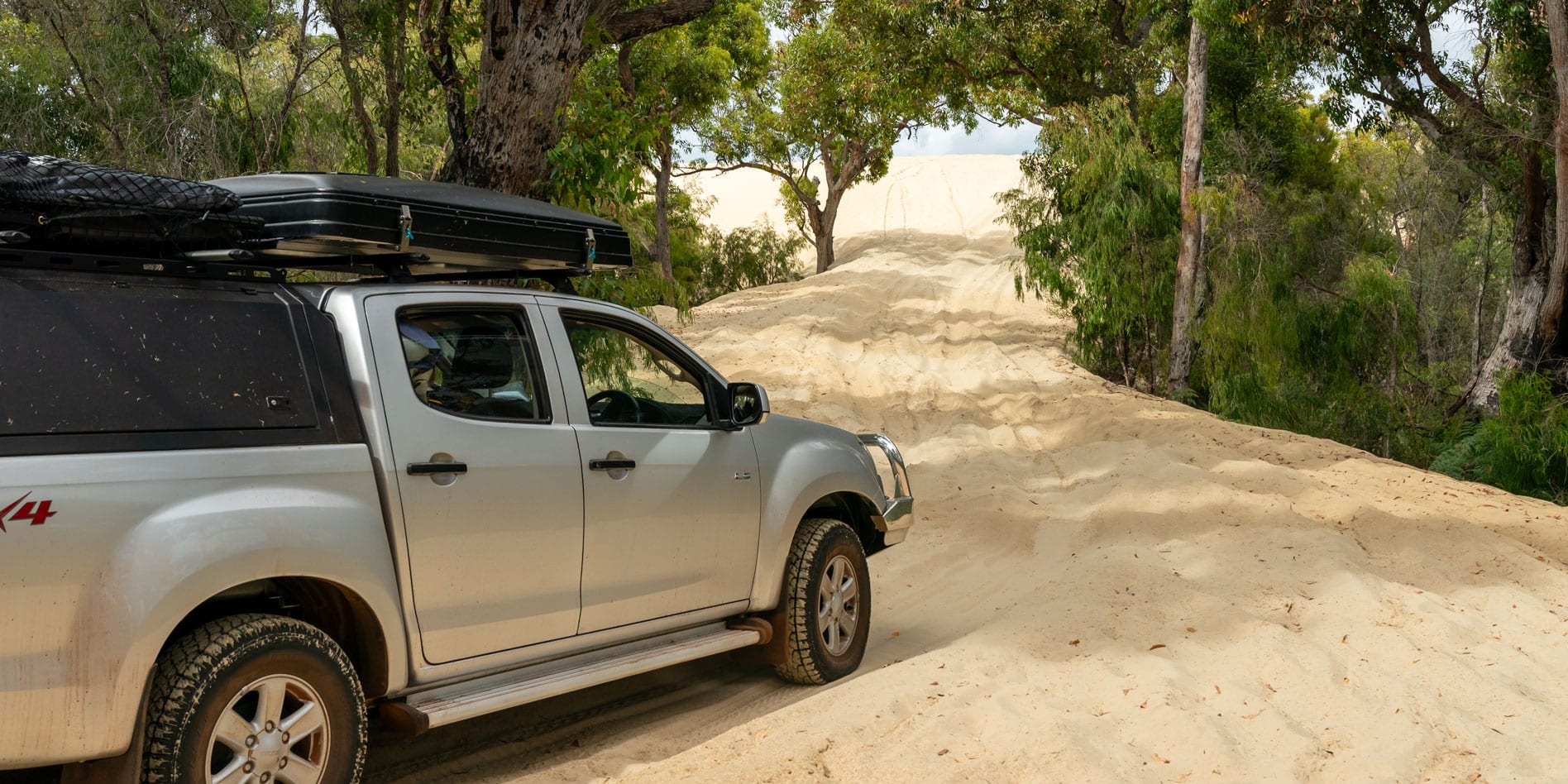Have you ever thought about what it’s like to drive the largest land-locked mobile sand dune system in the southern hemisphere?
Well, here’s your chance.
The magnificent Yeagarup sand dunes in D’Entrecasteaux National Park can be legally driven, and you don’t need to be an ace driver to do it.
In this article, I walk through the preparation, the drive and things to be aware of to help those first-time Yeagarup Dunes and Yeagarup Beach drivers. This was my first time driving both the dunes and the beach.
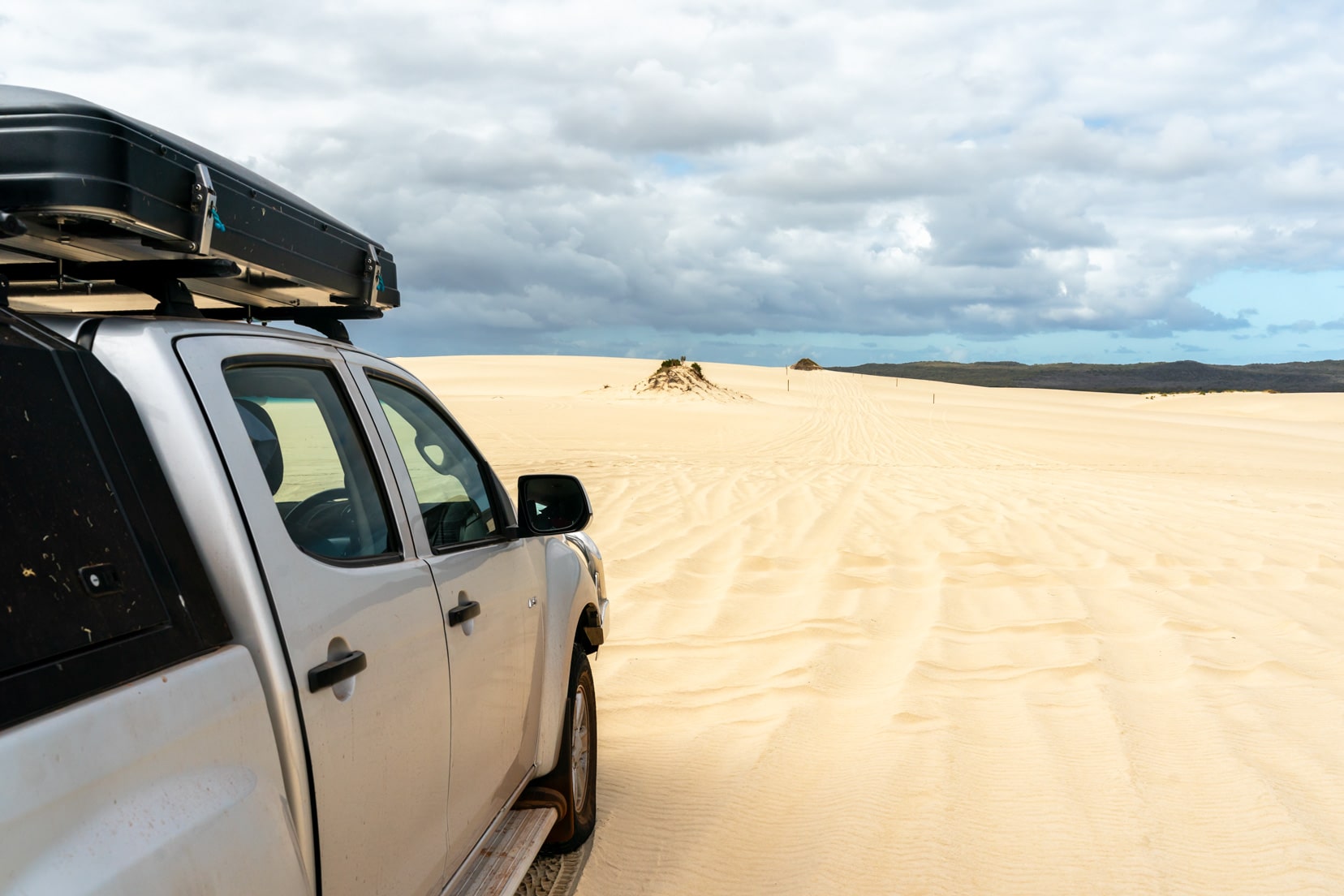
We made a detour on our Perth to Albany road trip in the southwest of Western Australia to see for ourselves just how spectacular these dunes were.
They didn’t disappoint. We also drove along the pristine Yeagarup Beach.
Driving the sand dunes reminded me of when we drove Namibia’s Sossusvlei and visited Sandwich Harbour’s massive Namib sand dunes.
In addition to our Isuzu 4×4 in Australia, we have a South African registered Toyota Hilux, currently stored in Botswana, which we have been using to overland Africa for the past few years.
So, as you can see, we’ve had a lot of fun 4WD times.

Our Local Tip: If you want more beach 4-wheel driving, you can’t beat the beaches around Esperance, such as Lucky Bay and Wharton Bay, among my favourites.
Head into Cape Arid, WA, and take Fisheries Road from Esperance to Israelite Bay for a more rugged and challenging drive.
If you’re in a hurry, click on any of the headings below to go straight to that particular article section. Here are the main topics I cover:
- Where are the Yeagarup Dunes?
- What does it cost to drive to Yeagarup Dunes?
- What sort of vehicle do I need to drive the dunes?
- Where can I overnight near Yeagarup Dunes?
- What essential equipment must I bring with me?
- How much time do I need to drive to the dunes and Yeagarup Beach?
- Our drive with video.
Good to Know Before You Drive the Yeagarup Dunes and Yeagarup Beach
To start your trip planning, I’ve included the most important information that can help get your adventure underway.
What are the Yeagarup Dunes?
The Yeagarup dunes are a land-locked series of sand dunes covering an area of approximately 30 square kilometres (10km x 3km) that are slowly moving inland, enveloping the nearby ancient Karri trees.
Actually, the sand is moving 4m every year due to the strong southerly winds.
This dune system is huge. When I initially saw the photos, they didn’t seem impressive, but how wrong I was! At the base, the face of the dune rises to heights of easily 40-plus metres.
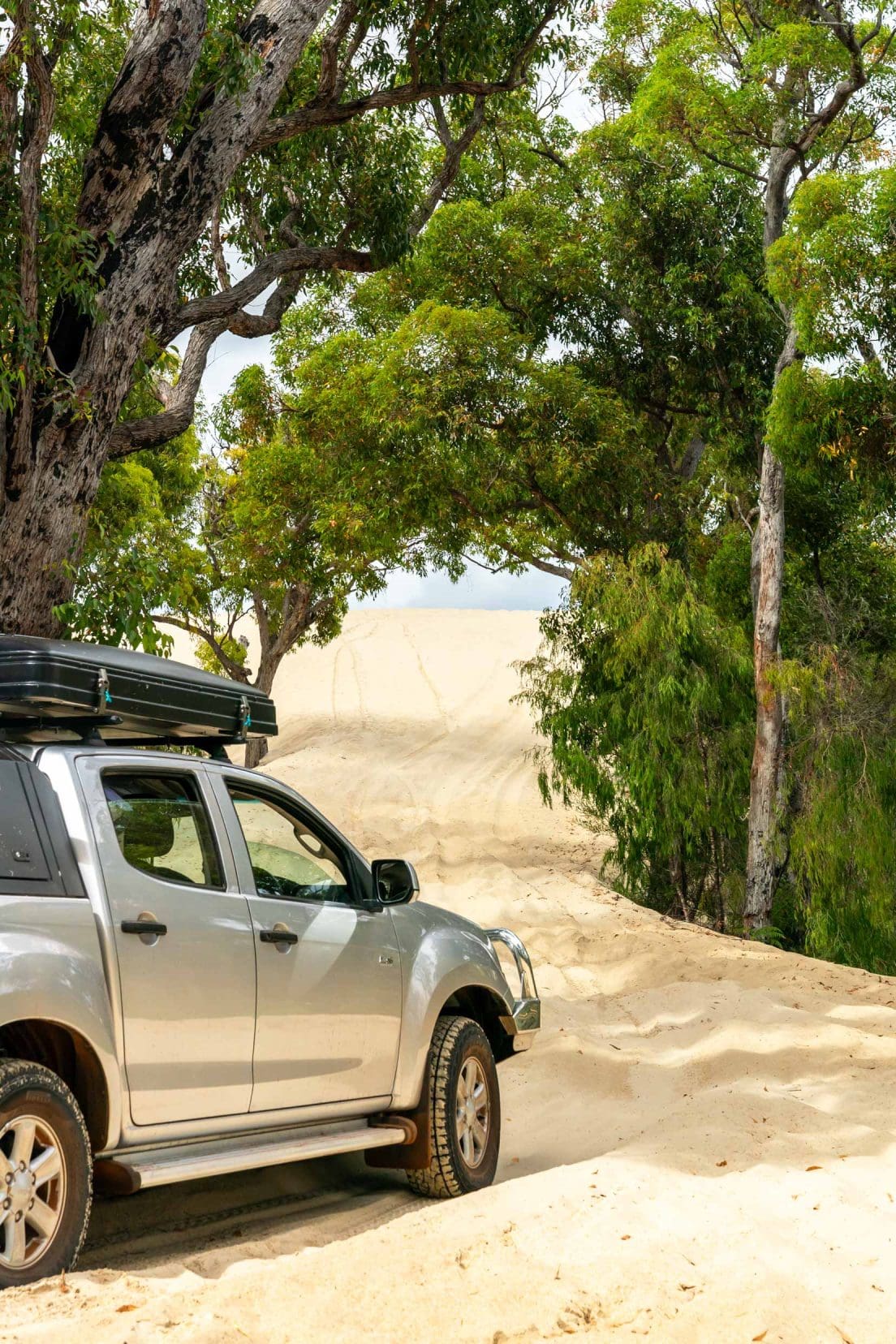
Where are the Yeagarup Dunes?
The dunes are located 25 km SW of Pemberton and 370 km south of Perth, within the D’Entrecasteaux National Park.
The unsealed 2WD Ritter Road provides the only access to the Yeagarup Dunes and beach.
The Lake Yeagarup picnic area, toilet and park registration station are at the southern end of Ritter Road.
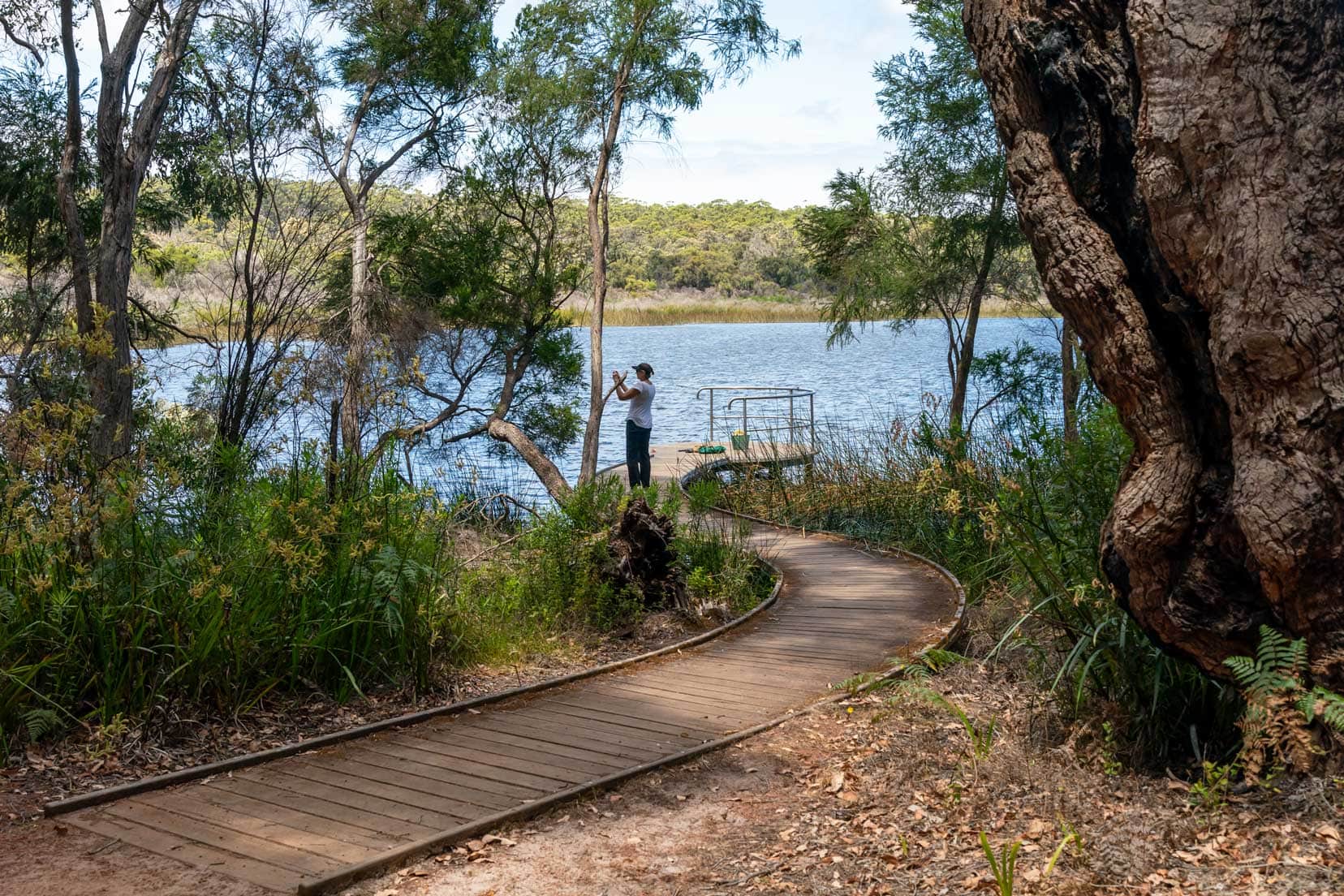
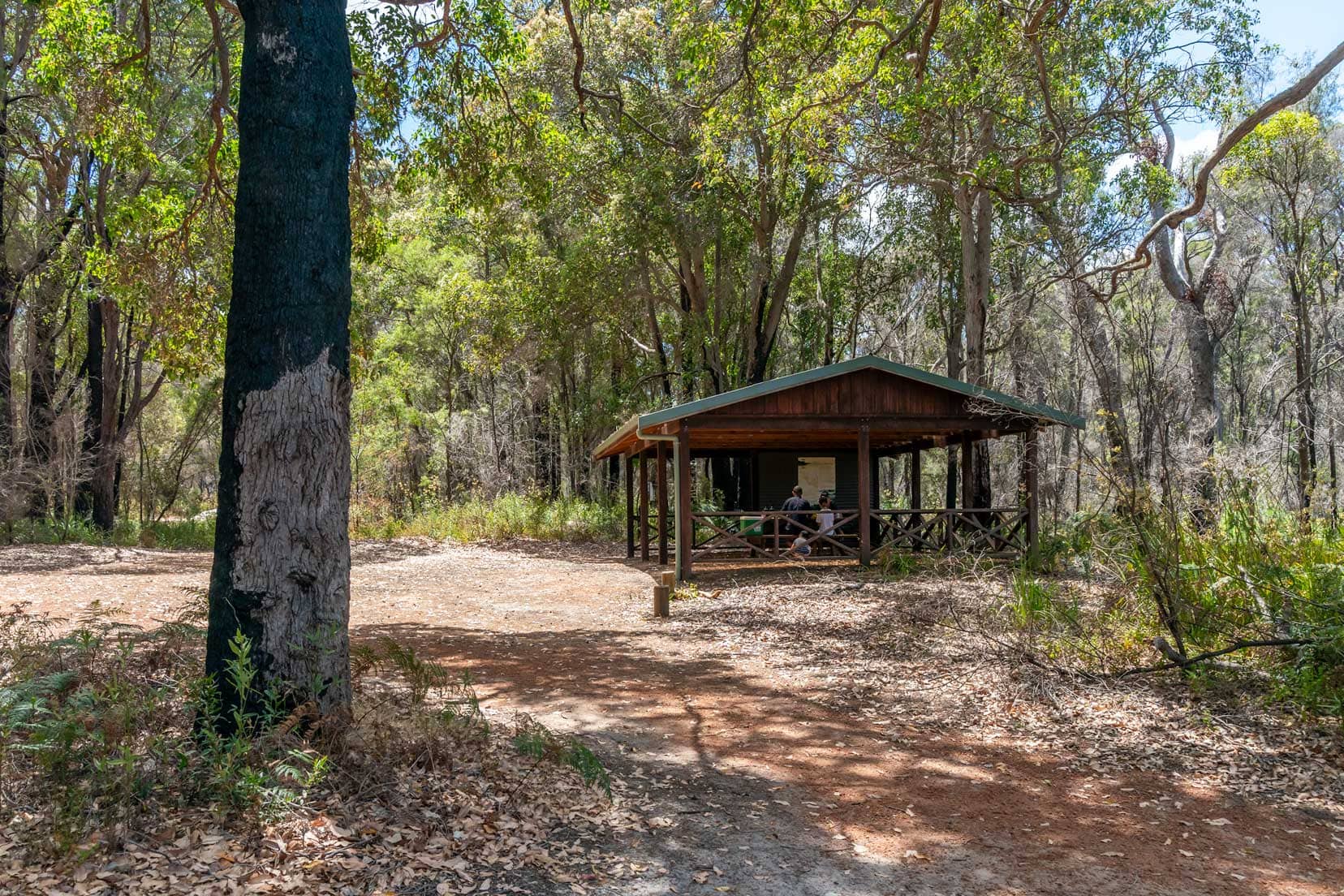
The park registration station is nearby. If you intend to walk the dunes, park your vehicle here. Follow the 4WD track for roughly 1.5 km to reach the dune base.
Are the Yeagarup Dunes free to drive?
Yes. The dunes are free to drive; however, as the dunes are located within the D’Entrecasteaux National Park, park entry fees apply.
The fees below are taken from the DCBA (Department of Biodiversity, Conservation and Attractions) website:
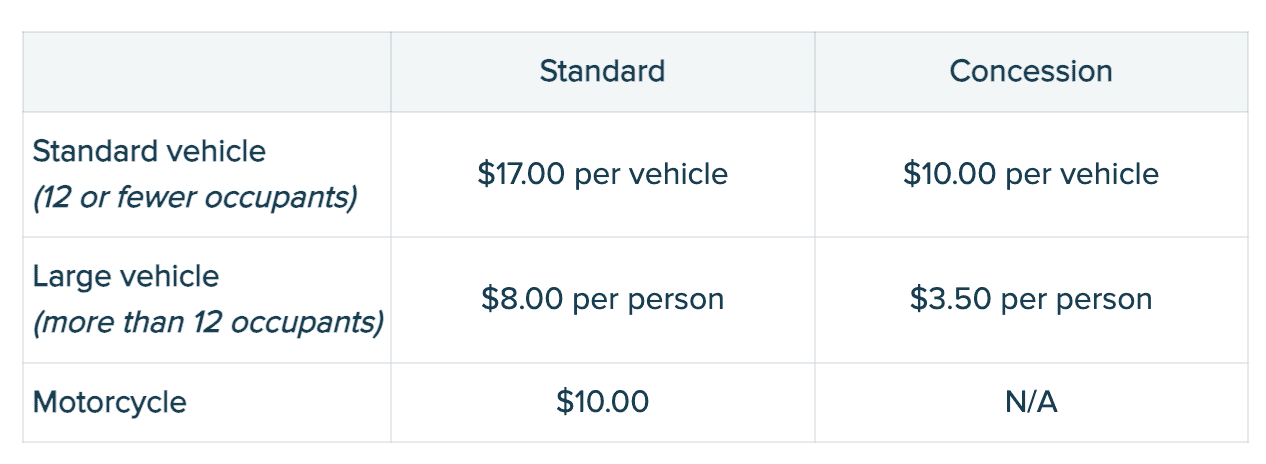
Electronic payments only, can be made near the park registration shelter.
If you already have a valid park pass, you can enter the park and start the dune drive, but remember to display your park pass on your dashboard.
If camping, park entry is paid only on the first day of the park visit, so campers may leave and re-enter a park during their stay without incurring additional park entry fees.
What Sort of Vehicle Do I Need?
You must have a 4WD if you intend to drive the dunes and beach.
If you don’t fancy dune driving, an alternative option is to park at the southern end of Ritter Road near the registration station and walk the 1.5km track to the dunes.
Or, let someone else do the driving and join a Pemberton Discovery Tour.

⭐️⭐️⭐️⭐️⭐️
Half-Day Tour to Yeagarup Dunes, Pemberton and Warren National Parks.
✔️ Lunch
✔️ National Park Fees
✔️ Hotel pick-up/drop-off
✔️ Excellent Reviews
⭐️ Rating: 5/5 Stars | ⏳ Tour Length: 4 hours | 🦭 Check Rates and Availability
Do I need any special equipment for driving the Yeagarup Dunes?
✅ Yes, it’s essential that you have an air compressor with you to be able to inflate your tyres and a hand-held compressor gauge to verify air pressures when deflating tyres.
Recovery tracks and a spade will also help if the vehicle becomes bogged.
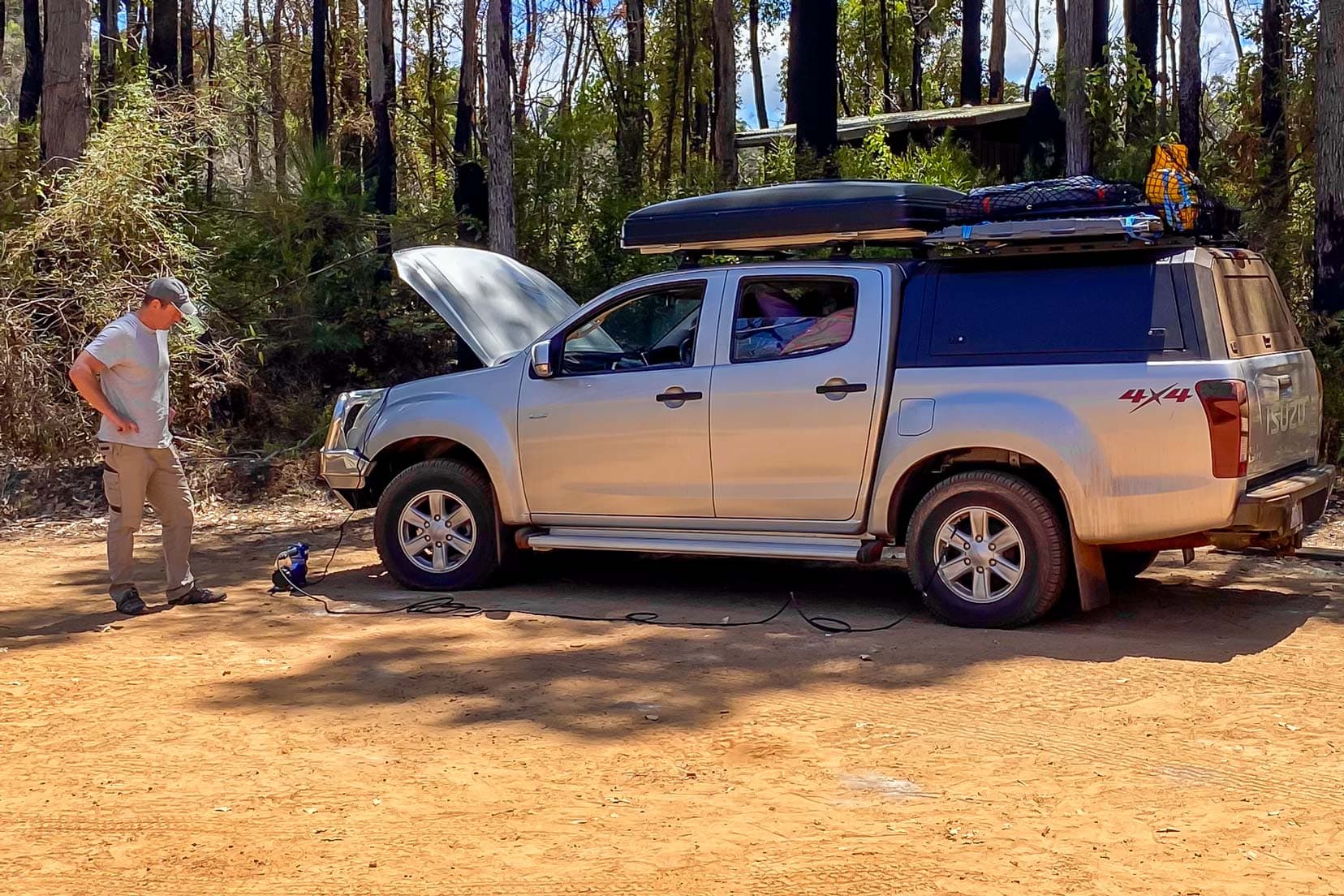
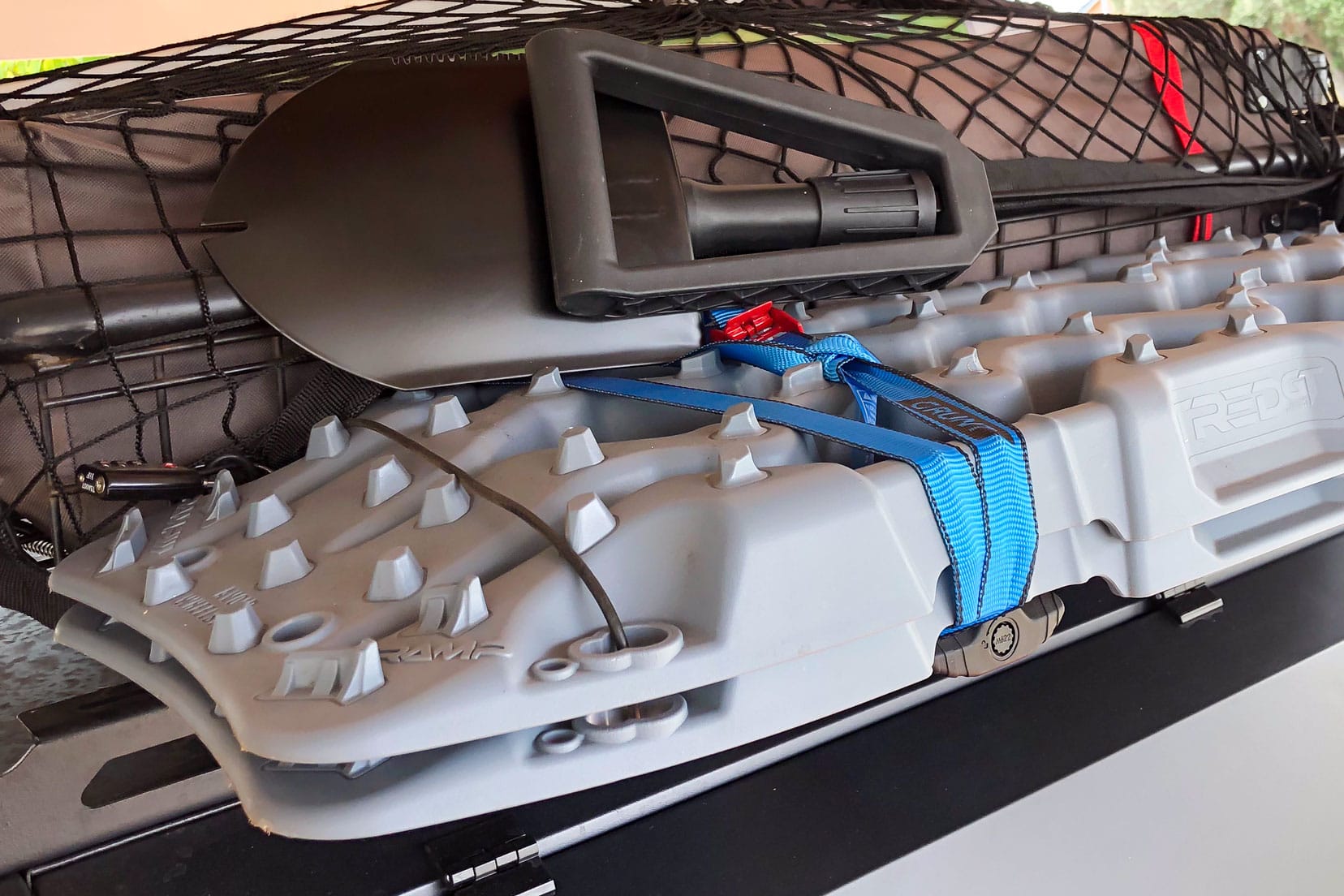
Can I take my camper trailer onto the Yeagarup dunes or beach?
❌ No, you can’t take your camper trailer onto the dunes or beach due to the soft sand and steep tracks.
Can I take my pets to the D’Entrecasteaux National Park?
❌ No pets are allowed in the D’Entrecasteaux National Park.
Where can I camp near Yeagarup Dunes?
The closest camping is available at the Leaning Marri campsite, located at the southern end of Ritter Road. This campsite cannot be booked in advance and works on a first-come/first-serve basis.
Eight single camping spots are available; one group camping site is behind the registration shelter.
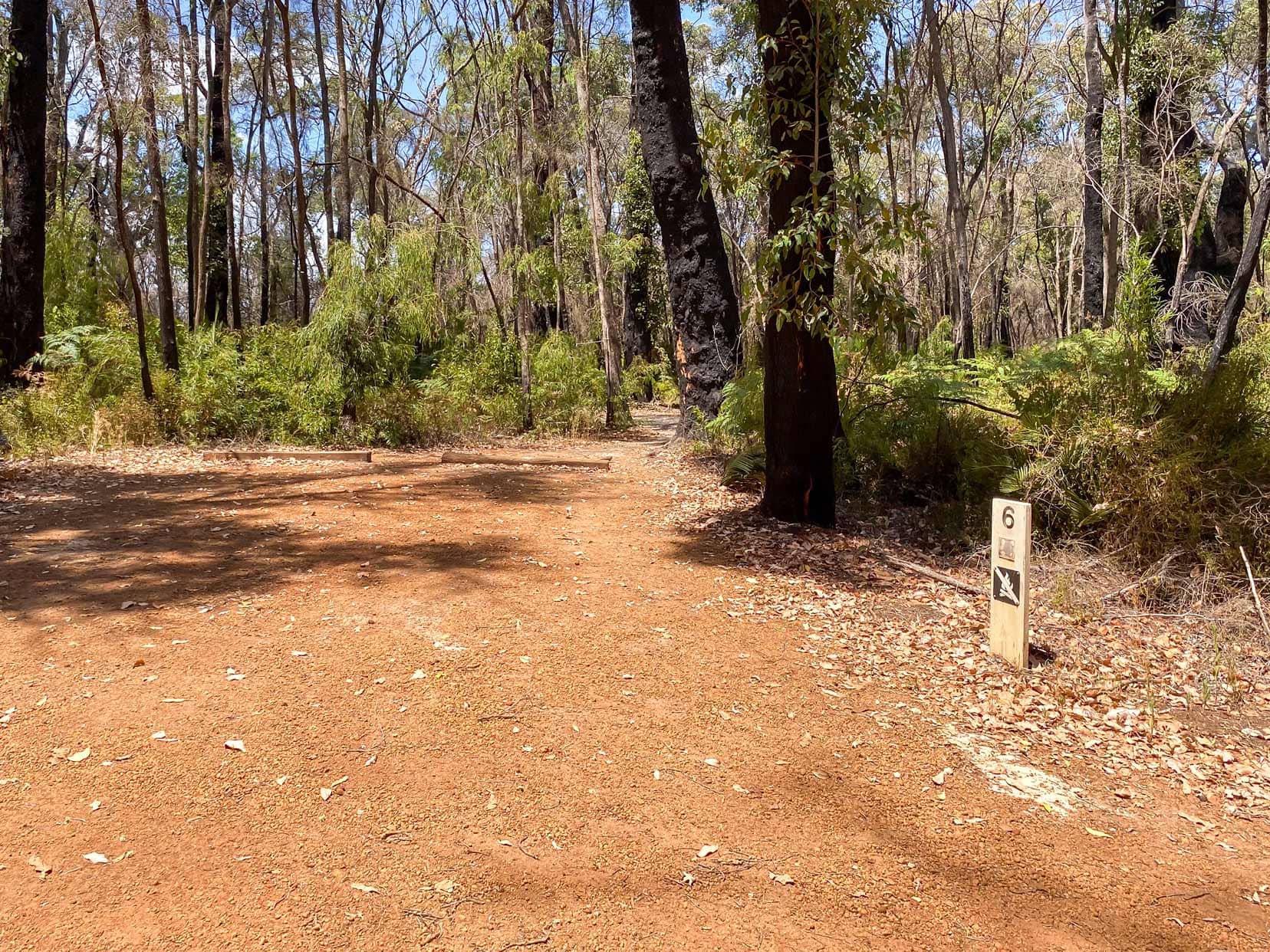
All sites are unpowered, and most have a little shade. There is a toilet at the campsite but no shower.
Payment for camping is not done on-site, relying on you to either pay in person at Manjimup or Pemberton DCBA office from Monday to Friday (08.00 am to 4.30 pm) or email [email protected].
Below are the camping fees taken from the DBCA website that apply at most campgrounds in Western Australia’s national parks and are charged ‘per person per night’.

I do mention possible wild camping spots further down in this article.
How Much Time Do You Need to Drive the Dune and Beach?
We took about two hours (with a few stops for photos) from the registration point to Yeagarup Dunes and onto the Beach. We didn’t drive all of Yeagarup Beach, but it was certainly enough time to enjoy this slice of paradise off-the-beaten-track.
If only driving the dunes, then a couple of hours would be enough.
Is there Network Signal at Yeagarup Dunes?
Yes, there is network signal at Yeagarup Dunes. We use the Telstra network, which has the best coverage in remote areas; however, I can’t vouch for other network providers.
What to Dial in an Emergency?
Call ‘000’ when any network provider’s signal is available (for Australian phone service providers) or ‘112’ for international service providers, which will divert to ‘000’.
You can also download the Emergency+ app, which can be used for any type of emergency and connects using a network signal. If there’s no network signal, then it provides just a GPS position.
Travelling with a personal locator beacon (PLB) is the best choice as it uses satellites for communication, not needing to rely on phone networks. Great for remote locations.
Where is the closest fuel and supermarket to Yeagarup?
The closest fuel and supermarket can be found at Pemberton, 24 km from the Leaning Marri campsite.
4×4 Driving of Yeagarup Dunes and Beach – The Lowdown
I best start by telling you a bit about my ‘fourby’. It’s a stock standard 2014 Isuzu DMAX. No lift kit or modifications have been done to this ute. It has 16” rims with Light Truck all-terrain tyres, 245/70s.
I completed this drive on a hot Summer’s morning; the Isuzu was fully fuelled, carrying all my camping gear plus 75 litres of water … and my wife, Shelley 🙂 of course. I was testing the car under its heaviest load.
Below are the video highlights from the drive, mostly taken with a GoPro 11 sitting on the bonnet and supported with iPhone footage.
Preparation: Air Down the Tyres
The park registration station has a wide, open area, which is the perfect place to park to air down/up your tyres.
When driving in sand, selecting the right tyre pressure, I would say, is the single most important detail to avoid bogging.
I spoke to a fisherman who was departing Yeagarup, and he said 12 psi did the trick for him, plus plenty of power going up any dunes. So, 12 psi it was.

I later saw a national park sign indicating that 10 psi was the recommended pressure. Engaging 4×4 High (four-wheel drive), I started the drive and would remain in 4×4 High for the duration.
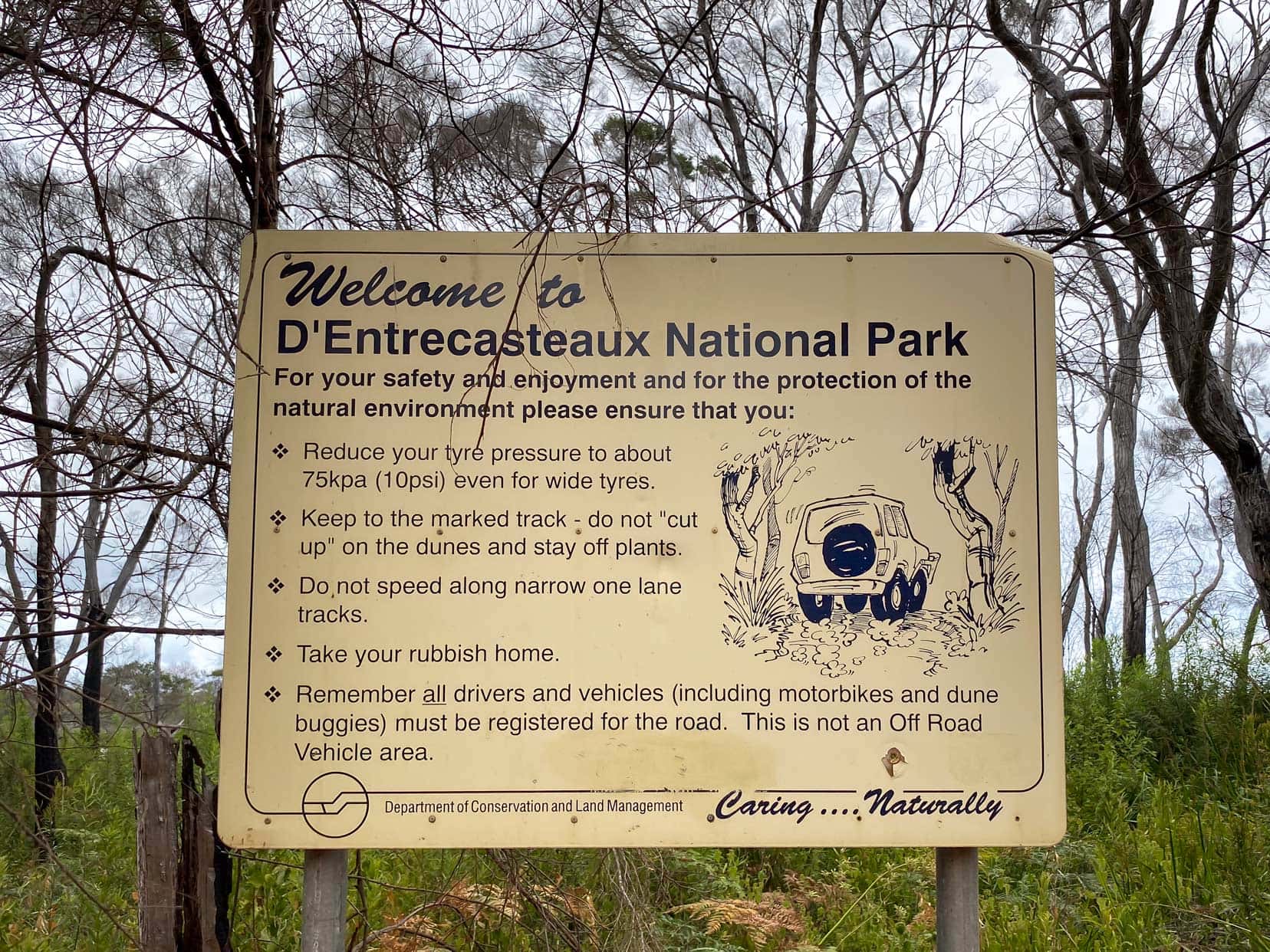
Initial Ascent onto the Yeagarup Dunes
Driving the 1.5km from the registration station to the start of the first dune ascent was easy. The track is reasonably compacted sand, and the undulations start early, just as you pass Lake Yeagarup.
The drive is pretty slow going.
Although it’s a single track from the parking spot to the start of the dunes, there are plenty of spots where two vehicles can pass each other.
If you only intend to drive the dunes themselves and not continue onto Yeagarup Beach, then this first ascent is the hardest part of the drive.
From the base to the summit, it is around 40m in height, with the total driveable distance being roughly 120m. The sand is soft and boggy due to the many vehicles that have churned up the sand.
There’s no alternative easy route; it’s up and over.
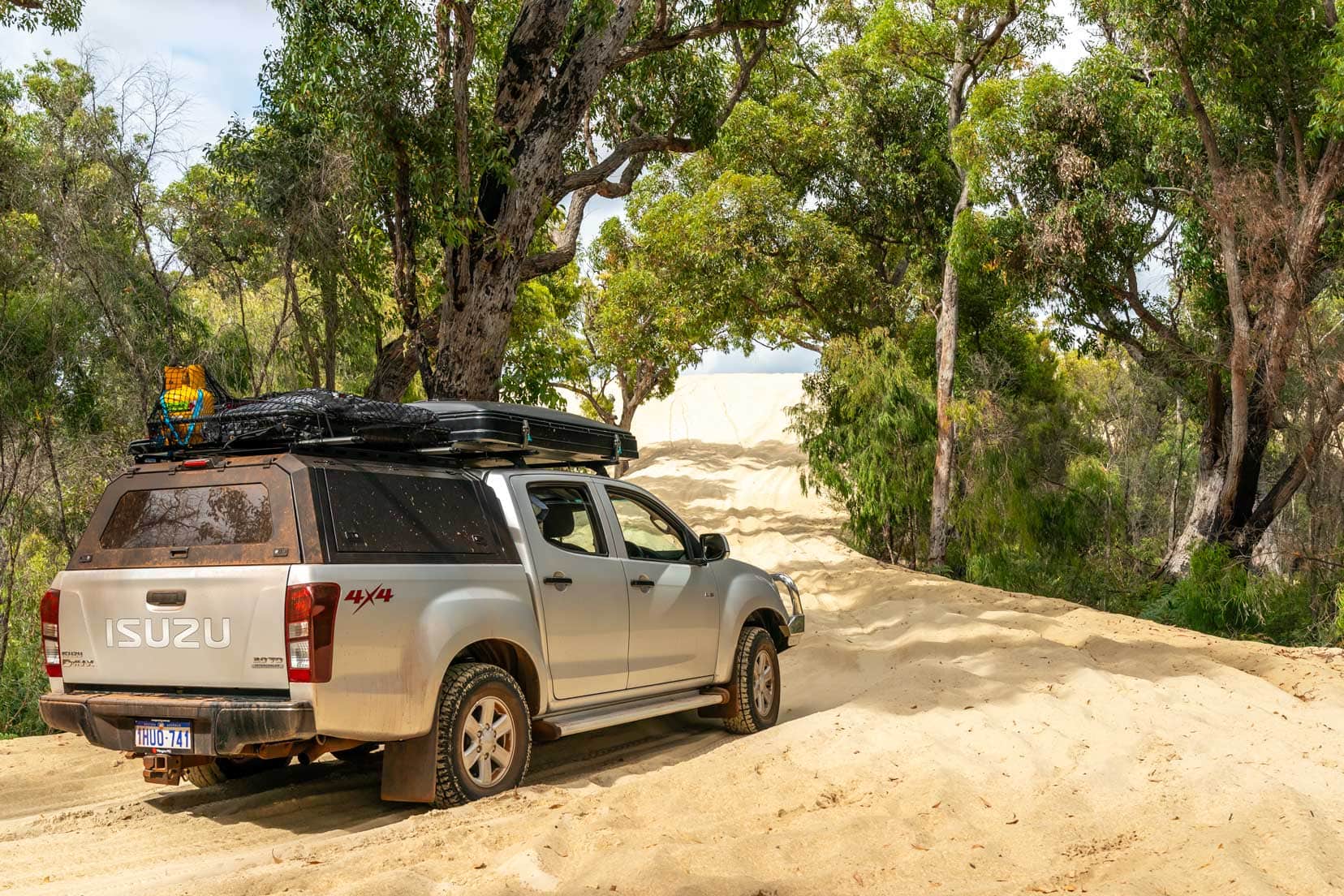
I walked a bit of the track to pick the best driving line to avoid the worst of the sand undulations. These cause the vehicle to wash off or lose speed.
A 60-degree turn leads to the start of the dune climb, so I reversed back around this for a longer run-up. Keeping the foot down all the way, I hit the start of the climb in 3rd gear at the highest speed I could, making it to the top on my first attempt.
The track is about two car widths at its narrowest point between the trees. If reversing after a failed attempt, you must be mindful of this.

On Top of the World – Dune Summit
From the top of the dunes, white markers to each side indicate the path where the vehicle must be driven. Magnificent views abound.

Be mindful that during the drive across the top, a few rises are blind to oncoming traffic, so toot your horn to indicate your presence.
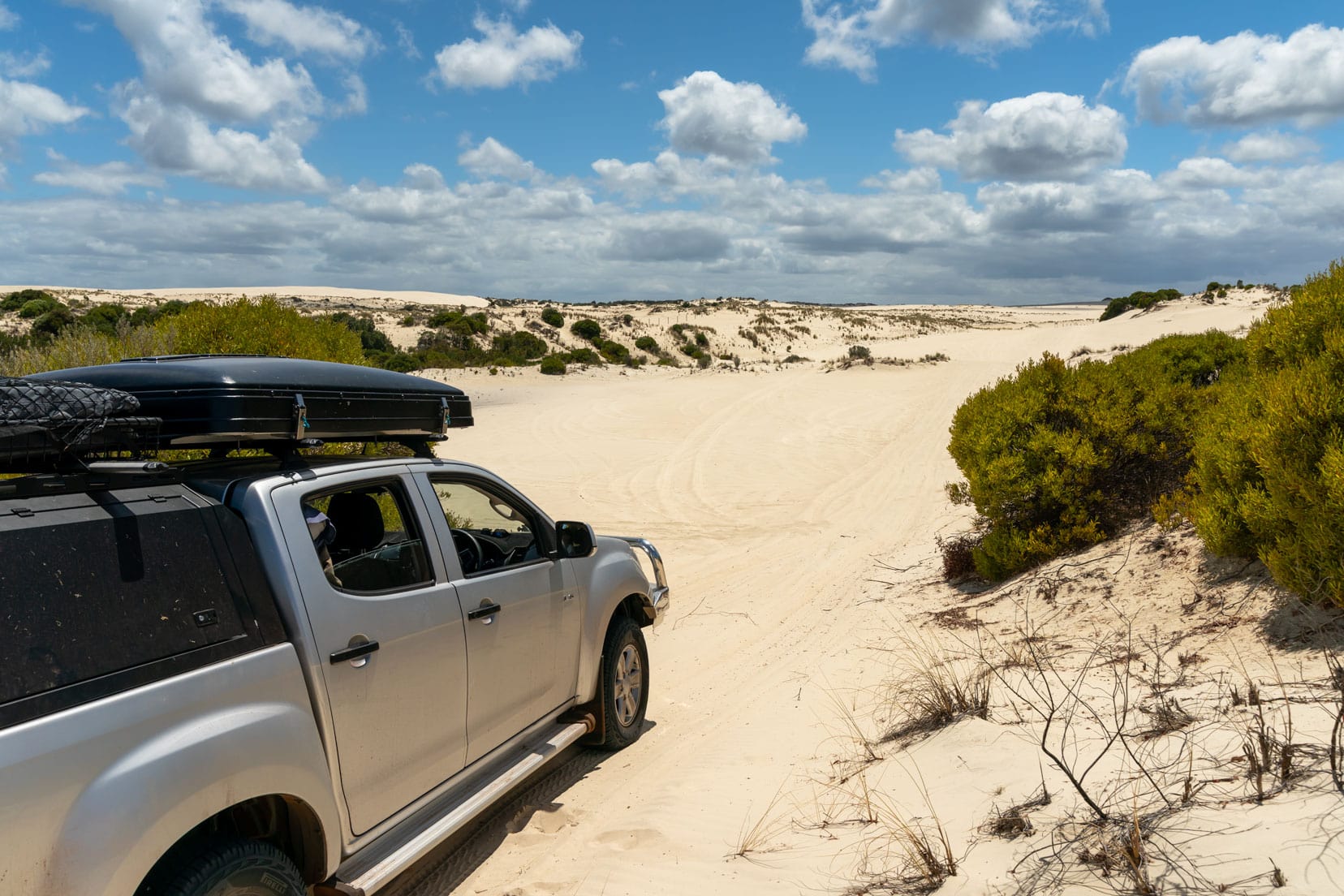
There is no real difficulty in driving the dunes themselves if you keep to the tracks of other vehicles. Following the white poles eventually leads you to the end of the dunes.
If you only intend to drive the dunes, this is your turn-around point. Simply follow your tracks for the return journey. However, we chose to continue the drive down to Yeagarup Beach.
Drive Down and Onto Yeagarup Beach
The distance from the main Yeagarup Dunes to the beach is roughly 8 km. The track is mostly a single-car width. About 1 kilometre from the beach, the track divides into two, and it’s here you have first views of the sea.
It’s an undulating track, so vehicle speed is quite low.
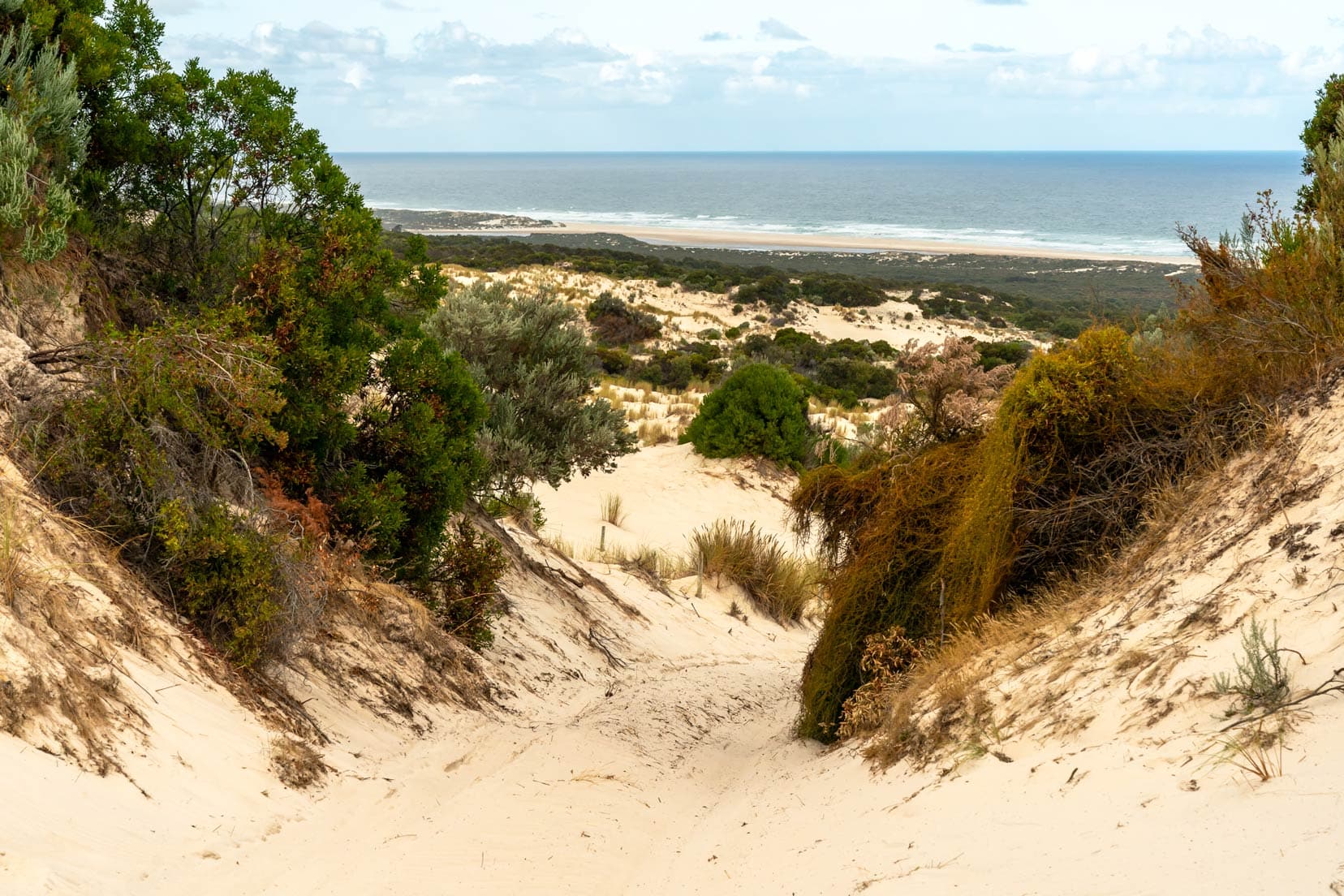
Roughly 2km from the beach, a long descent lies ahead. This section is the first of two tough sections to test you on the return.
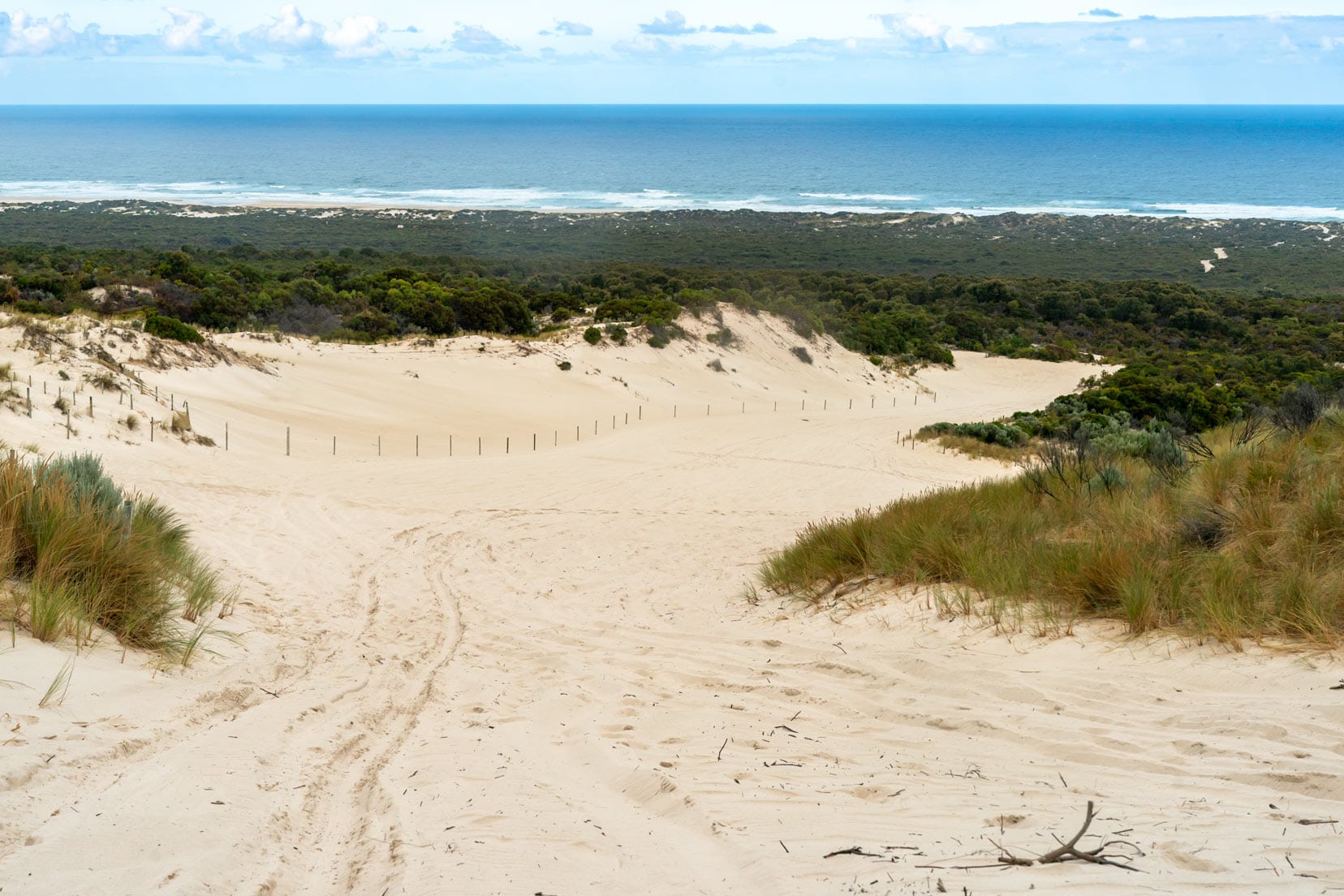
Halfway down this long section is a great flat wild camping area with a bit of wind protection that would fit about 12 vehicles.
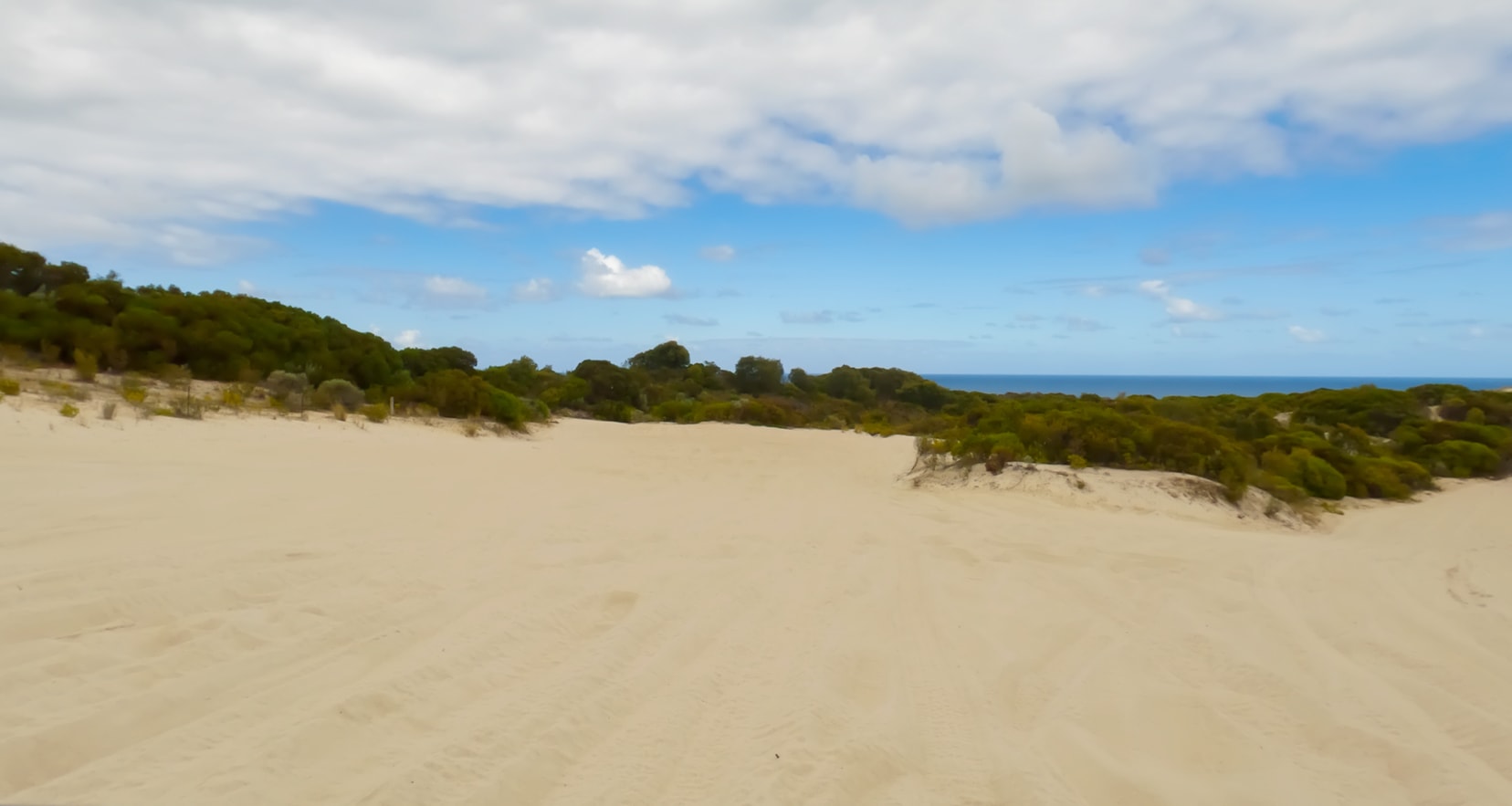
I also noticed a small second wild camping site that could fit maybe six vehicles if you fancied some Yeagarup beach camping (approximate coordinates are S34.59294, E115.81111).
After the long descent, the track is easy to drive. It narrows in places, is quite undulating, and requires a slow speed to negotiate safely.
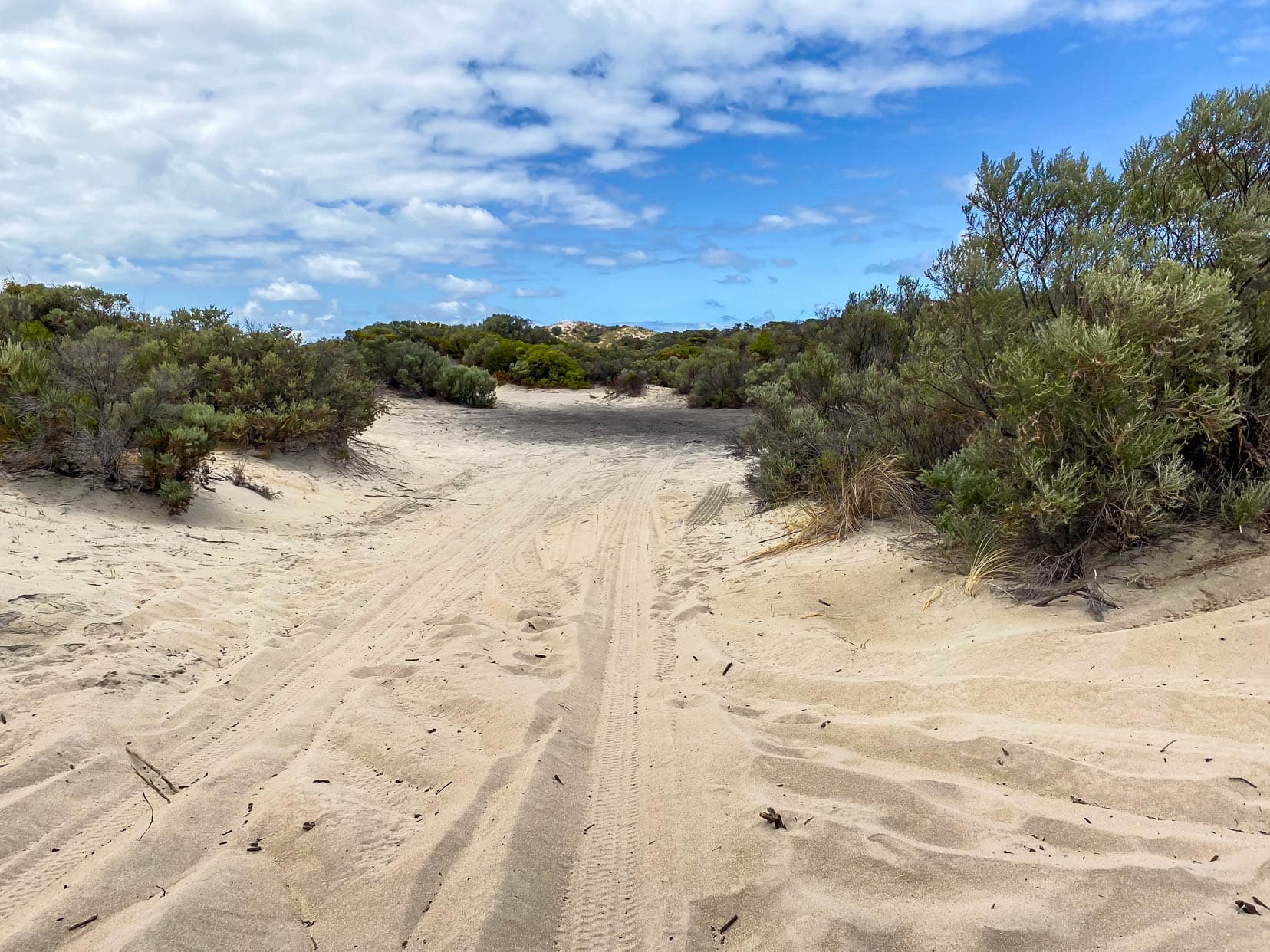
About 100m from the beach, a left and right track can be chosen at the Yeagarup Beach sign. Both track options are boggy, but sticking to the left track made more sense, which I chose.
No problems going down to the beach, but the return leg on this same stretch of soft track would prove a bit challenging.
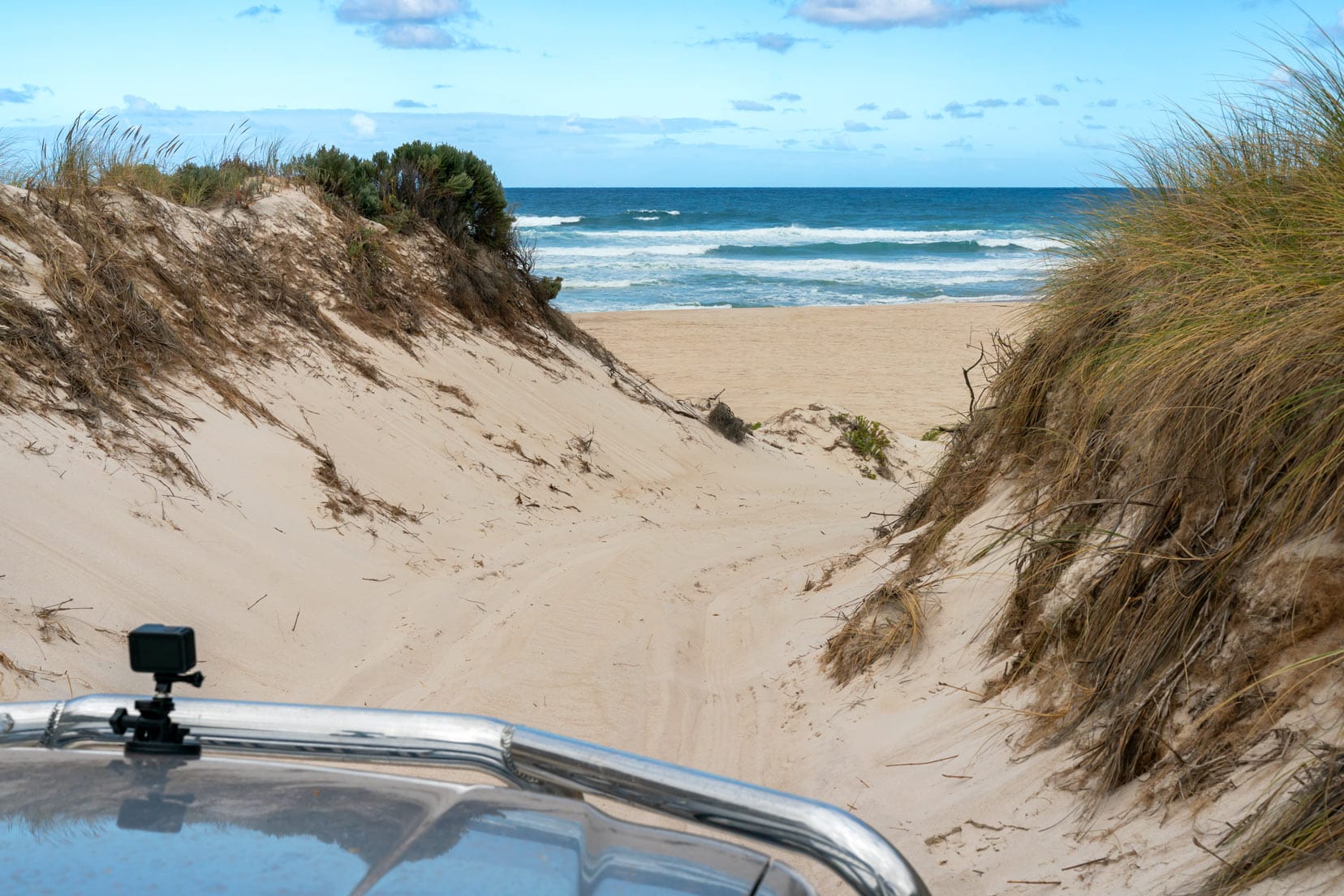
Now, on Yeagarup Beach, a 1.5-kilometre drive east brought me to the mouth of the Warren River. I did not proceed any further. The sand discolouration also indicated there was moisture present, and that could lead to bogging problems.
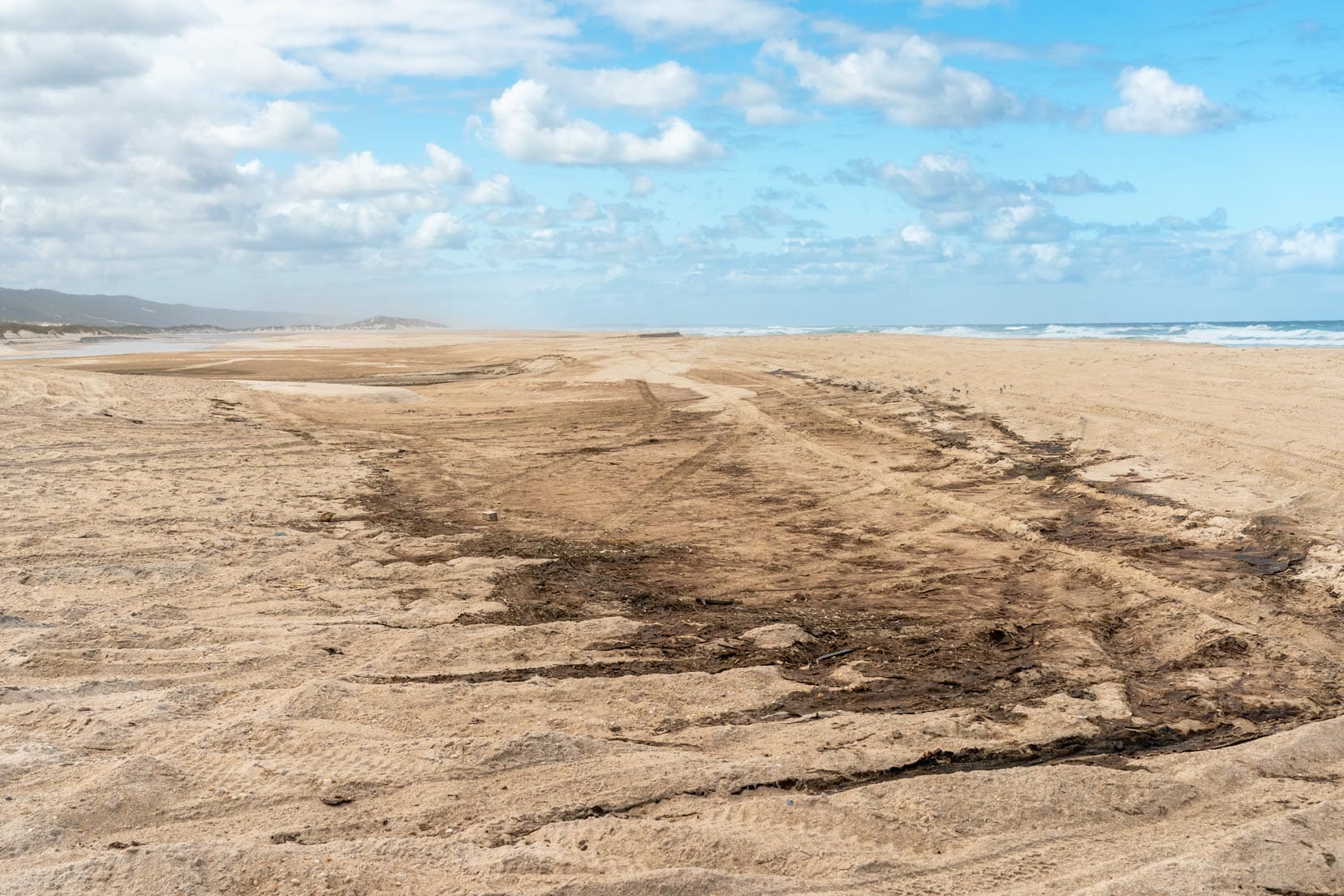
Personally, I had little beach driving experience, and we were a lone vehicle, so it was an easy decision to make. I had checked the tides for that day: high tide was at 05:00 am and low tide at 19:55 pm, so we were well within the safe tidal window, having hit the beach at 10.30 am.

I turned the vehicle around and drove west for about 15 minutes, passing some fishermen, taking a few photos and enjoying the pristine scenery before deciding to start the return trip.
The surf was way too rough to consider a swim.

Negotiating the Return Drive from Yeagarup Beach
As mentioned, two tracks are leading from the beach. I did attempt the left track, but I quickly stopped due to a lack of speed and the sand being too soft. It took a couple of attempts using the right track (which I took onto the beach), with longer run-ups, to get up and over this.
The next hurdle was the long ascent up the hill with markers on either side. It was easy enough to drive halfway up, but then the sand became boggy.
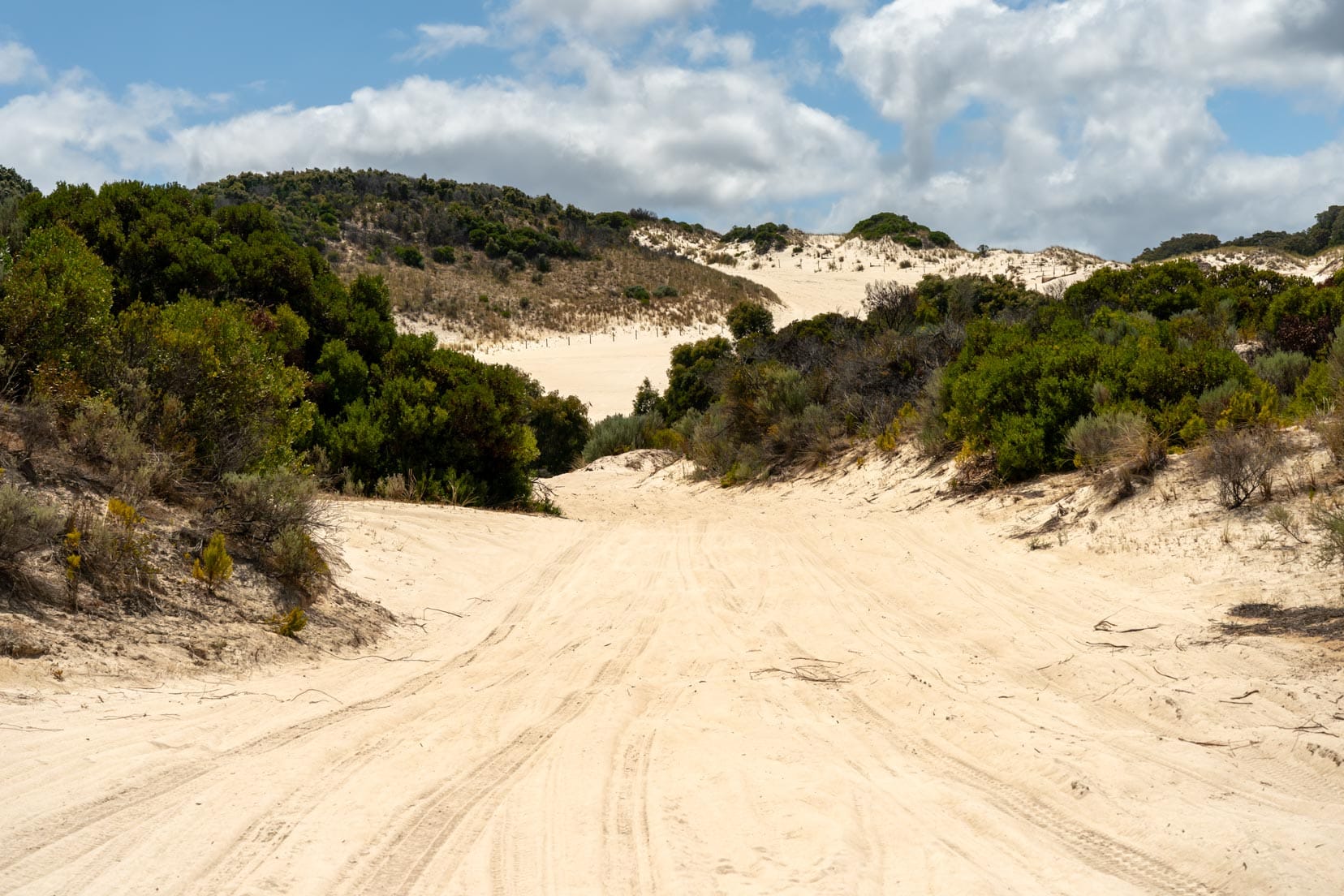
From here, there were two track options. I initially tried the left track but quickly lost speed and came to a standstill. The only option was the right track.
I put our auto into manual shift second gear, and my foot was flat on the accelerator. It took me three attempts to get up and over the summit, reversing a little further from the previous starting point for a longer run-up.
After this, it was a relatively easy drive back up and over the main Yeagarup Dunes. The descent off the sand dunes was done easily under the engine’s own revs.
Airing up at the registration station, the pressure in the tyres had increased from 12psi to 15psi due to heat build-up.
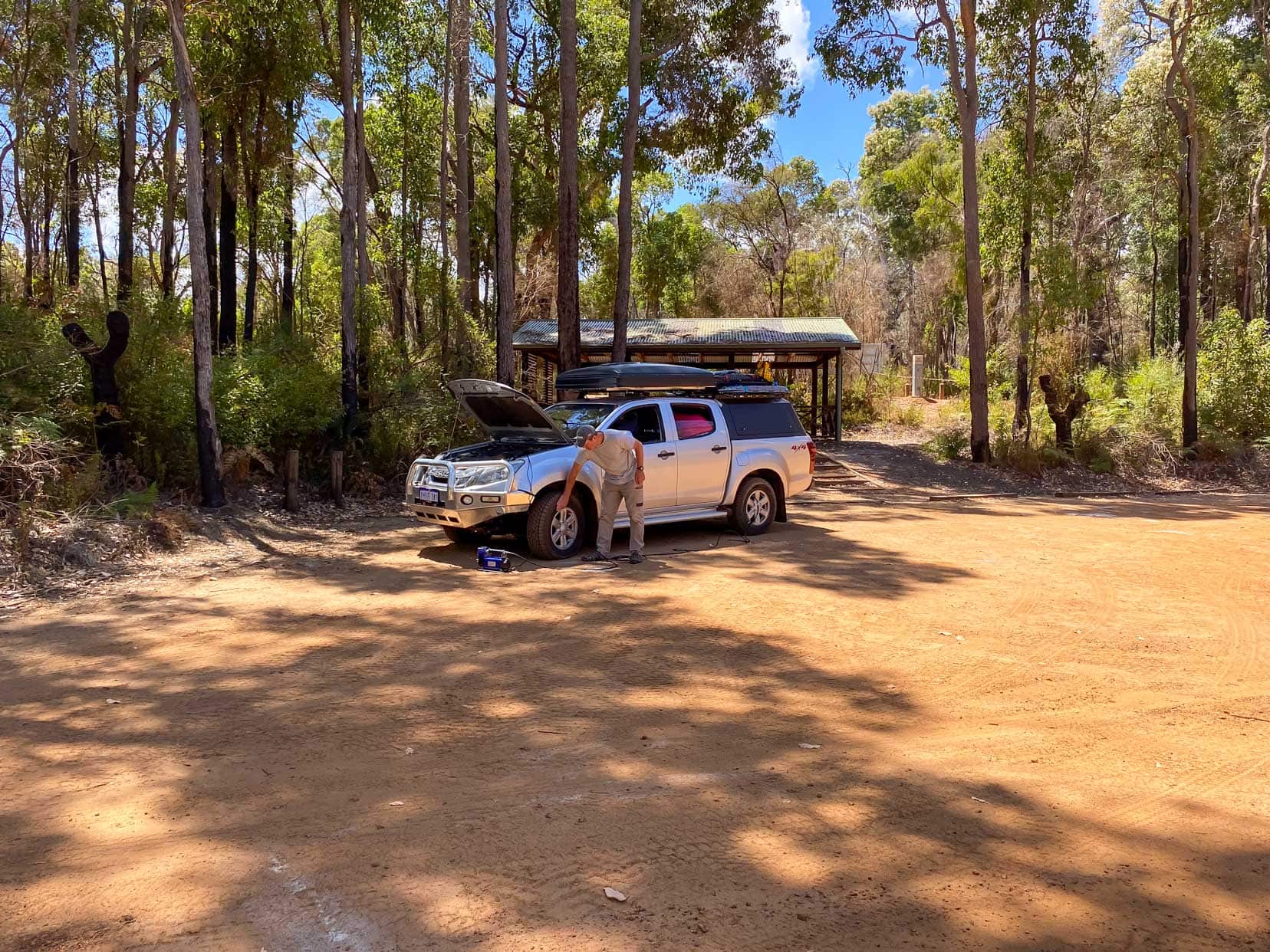
Challenging Parts of the Drive
There are just a few spots where the driving can get a bit challenging:
- The initial ascent onto Yeagarup Dunes
- From Yeagarup Beach to Yeagarup Dunes (return trip) when leaving the beach to join the track
- From Yeagarup Beach to Yeagarup Dunes (return trip): about halfway back when cresting the summit of the long ascent.
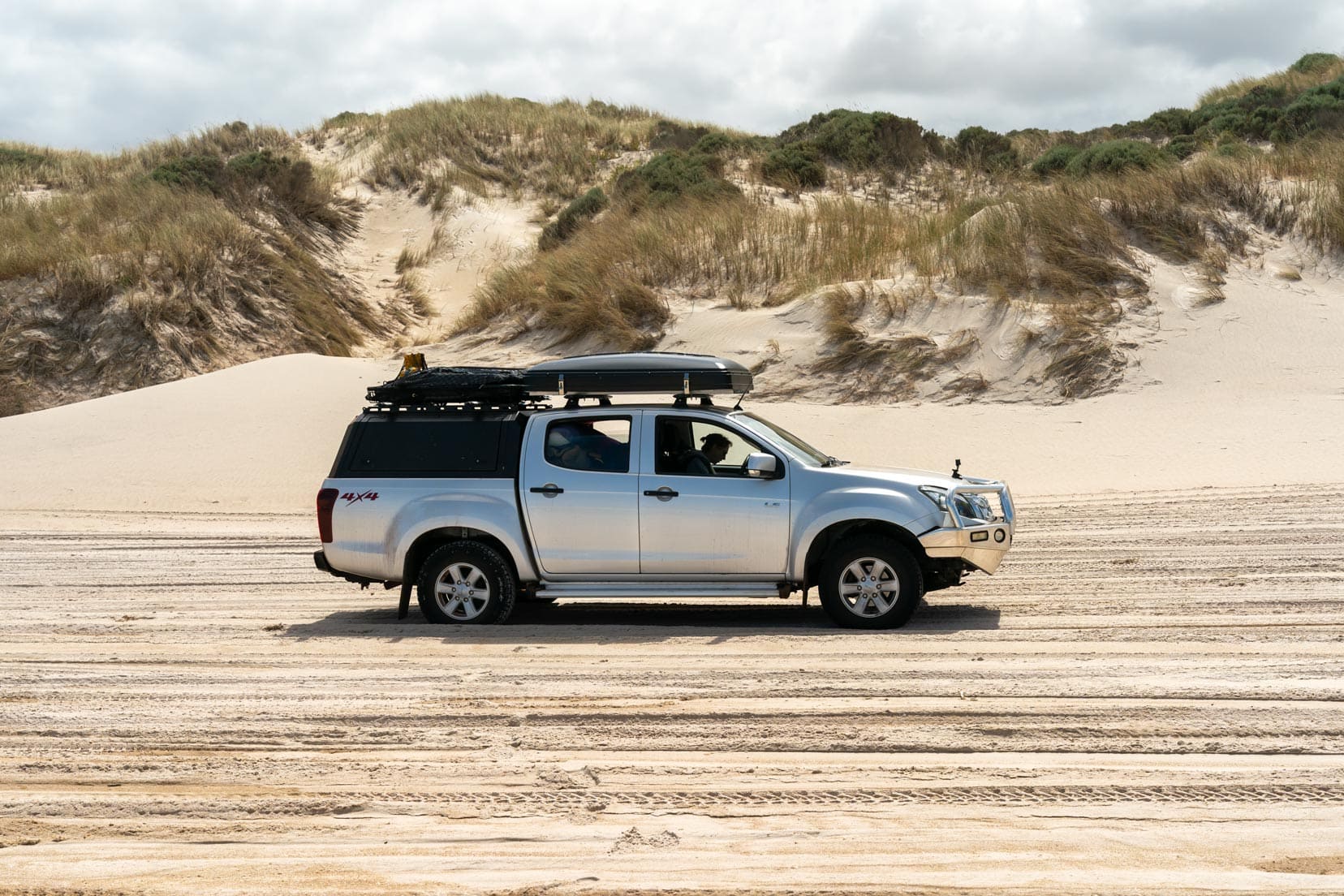
Actions to Further Reduce the Likelihood of Bogging
With hindsight, here are a few actions I could have taken to reduce the likelihood of bogging further:
- Check the air pressures a couple of times during the drive and deflate to maintain 12 psi.
- Drive earlier in the morning when the sand was cooler and more compacted before the sun could warm it up.
- My Isuzu was fully loaded with fuel, water, and provisions, so reducing any of these would lighten the vehicle and help it ride over the sand.

Discover More Around Pemberton
After your exhilarating adventure through Yeagarup Dunes, the journey doesn’t have to end. The Pemberton region and its surroundings are a treasure trove of natural wonders and unique attractions.
Here’s a curated list to inspire your next adventure:
- Gloucester Tree: Though not open for climbers at the moment, taking a peek at this towering lookout tree among the giant karri forests is still worth a quick stop.
- Beedelup Falls: Marvel at the serene beauty of these falls, set amidst the tranquil backdrop of Beedelup National Park.
- Warren National Park: Wander through ancient karri forests, home to some of the tallest trees on Earth. We camped at Drafty’s Camp by the river for a few nights before driving the dunes.
- Pemberton Tramway: Experience the charm of yesteryear with a scenic tram ride through the heart of the karri forests.
- The Cascades: Enjoy the soothing sounds of water flowing over natural rock formations at this idyllic spot.
- Dave Evans Bicentennial Tree: This lookout tree is also currently closed to climbing, but worth a look and there’s a short walk you can take in the surrounding forest. We were hoping to spot the purple-crowned lorikeet that likes the area but we had no luck.
- Big Brook Dam: Perfect for a leisurely picnic or a refreshing swim in the clear waters surrounded by forest. Shelley visited here with her kids when they were little, and it’s perfect for families picnicking and swimming.
- Visit The Valley of the Giants: While among the tall Karri forests in Pemberton, drive a little further and visit the world-renowned Valley of the Giants Tree Top Walk in Walpole.
- Gnomesville: Take a whimsical detour to this magical village inhabited by thousands of gnomes. It’s a quirky, unforgettable experience that will delight visitors of all ages. Find your way to Gnomesville.
- Art and Nature Trail: Head to Northcliffe for the Southern Forest’s immersive experience of nature and art at the Understory Art Trail.
- WOW Ecocruise in Walpole: Embark on a serene journey through the Walpole and Nornalup Inlets Marine Park. This eco cruise offers a unique perspective on the region’s history, ecosystems and wildlife. And the tour guide is one of the funniest and most enthusiastic we’ve ever encountered.
Each of these destinations offers something special, ensuring that your visit to the Pemberton area and beyond is filled with memorable moments. Whether you’re seeking adventure, relaxation, or a touch of whimsy, you’ll find it here in Western Australia’s stunning southwest.
Drive Yeagarup Dunes and Beach … That’s a Wrap
Driving the famous Yeagarup Dunes is an experience every 4×4 enthusiast should add to their off-road bucket list. The thrill of driving the Southern Hemisphere’s biggest mobile land-locked sand dune definitely gains bragging rights.
The best part is that with some planning, the drive can be accomplished safely and with little dune driving experience. I hope you get to enjoy this beautiful part of the world.
Have you driven the Yeagarup Dunes or Beach? Have any questions for me? Drop a comment below!
For more great 4×4 experiences check out the beaches around Esperance and to really escape the rat race head into Cape Arid and make the trek across the sandy plains to Israelite Bay.
Explore more of Western Australia by checking out our interactive map and plethora of articles to find all the best places to visit in WA.
Save on Pinterest for Later
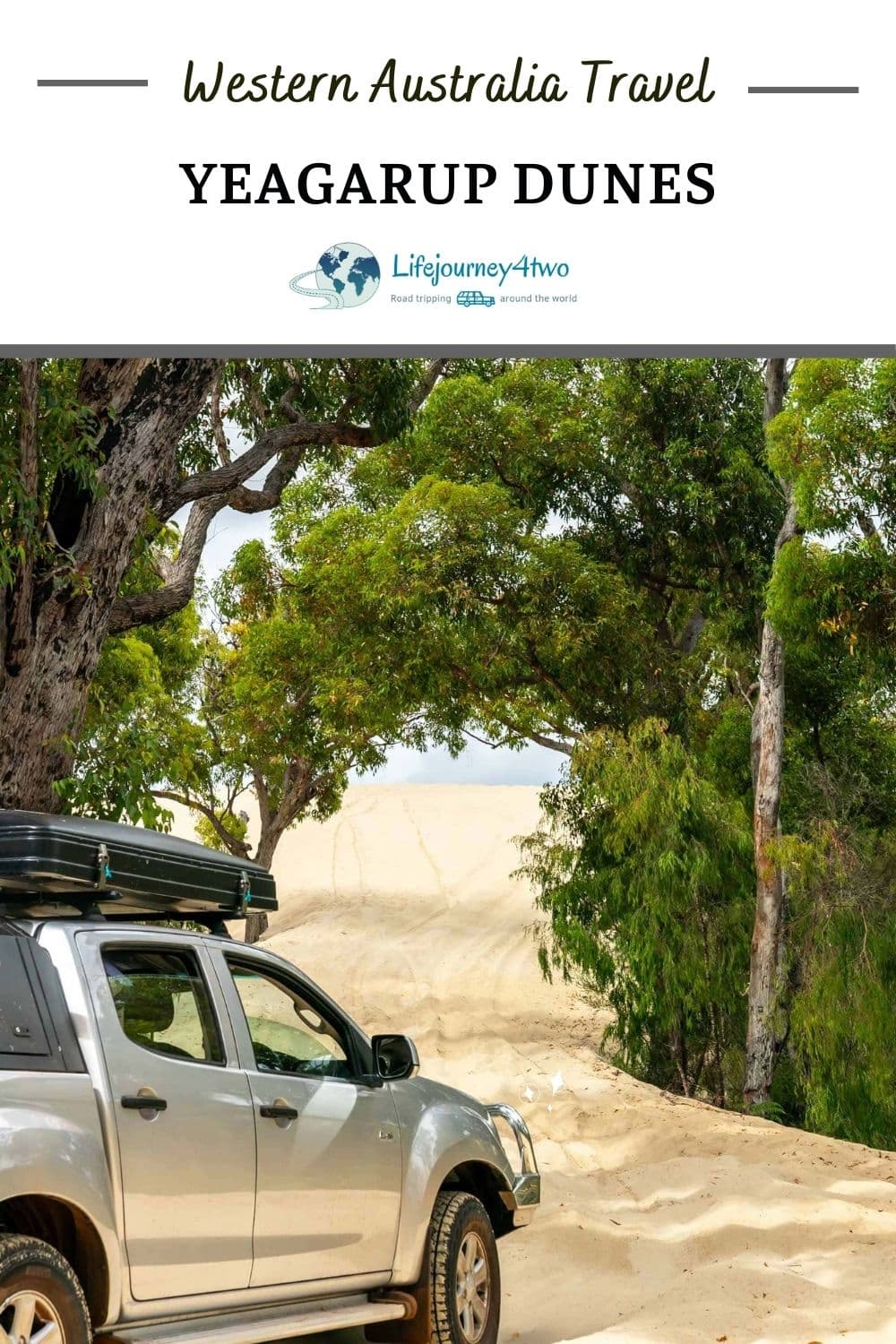
Planning Your Travels?
These are the travel resources we recommend and use when planning our trips.
- 🚘 Car Hire: We use DiscoverCars.com
- Motorhome/Campervan Rental: We highly recommend the Motorhome Republic
- 🪪 Order your International Driver’s Licence online here
- 🛏 Book Accommodation: We use Booking.com to find accommodation that suits our budget
- 🐶 Pet Sitting/Pet Sitters: Check Out TrustedHousesitters here (Use our Discount code: LIFEJOURNEY25 for 25% off. )
- Activities and Experiences: Get Your Guide and Viator
- Travel Insurance: Safetywing or World Nomads
- 🥾 Travel Gear and Accessories: Check out our top picks here — Lifejourney4two page on Amazon
For a more thorough list, visit our Travel Resources page here.

